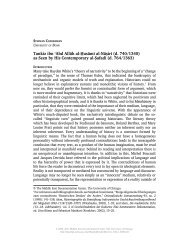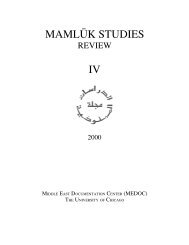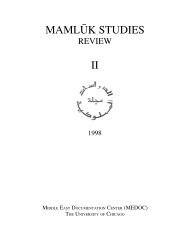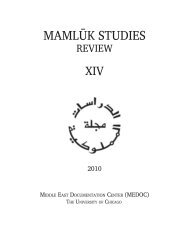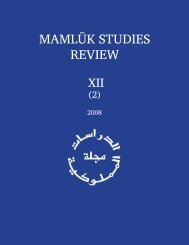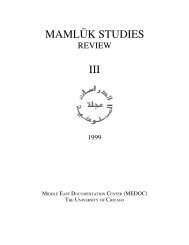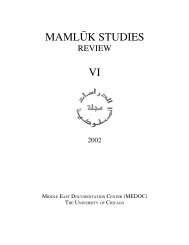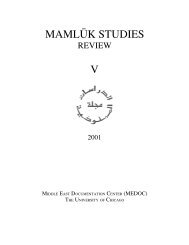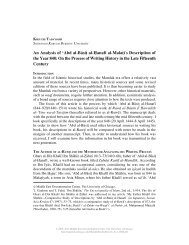Vol. VIII, no. 2 (2004) - Mamluk Studies Review - University of Chicago
Vol. VIII, no. 2 (2004) - Mamluk Studies Review - University of Chicago
Vol. VIII, no. 2 (2004) - Mamluk Studies Review - University of Chicago
You also want an ePaper? Increase the reach of your titles
YUMPU automatically turns print PDFs into web optimized ePapers that Google loves.
MAMLU±K STUDIES REVIEW VOL. 8, NO. 2, <strong>2004</strong> 15<br />
<strong>of</strong> Arabs were put to the sword, al-Nuwayr| reports that the <strong>Mamluk</strong> forces took<br />
1,600 Arab captives, who were all cultivators <strong>of</strong> the land (la-hum fila≠h˝a≠t wa-zuru≠‘). 57<br />
The booty was immense, including a substantial amount <strong>of</strong> agricultural products,<br />
such as oil taken from the local presses, and thousands <strong>of</strong> cows and oxen. Reportedly,<br />
the <strong>Mamluk</strong> armies could <strong>no</strong>t find buyers for the e<strong>no</strong>rmous amounts <strong>of</strong> grain<br />
(ghila≠l) they obtained during the suppression <strong>of</strong> the revolt. But when the troops<br />
returned <strong>no</strong>rth, they found the land empty:<br />
The troops made their way back on 16 Rajab (18 March 1302).<br />
[They found that] the land had become desolate, and one could<br />
walk and encounter <strong>no</strong> one on his way, or dwell in a village and<br />
see only women and small children. Then they decided to release<br />
the prisoners and let them go back, in order to sustain the land<br />
(li-h˝ifz˝ al-bila≠d). 58 That year, an unusually large portion <strong>of</strong> Upper<br />
Egypt was sown, followed by a harvest so bountiful it could <strong>no</strong>t be<br />
counted. 59<br />
Like the Arab tribesmen <strong>of</strong> the Fayyum, the majority <strong>of</strong> Arab rebels were peasants.<br />
Following the repression <strong>of</strong> the Arab revolt, the same Arab tribesmen who<br />
participated in the revolt, and who were killed or captured by the <strong>Mamluk</strong>s, were<br />
<strong>no</strong>w needed to cultivate the land. This passage has been <strong>no</strong>ted by both Poliak and<br />
Saleh, who took it either as a sign <strong>of</strong> the close alliance between the peasants and<br />
the bedouins, or as an indication <strong>of</strong> the increasing settlement <strong>of</strong> the <strong>no</strong>mads. Even<br />
Garcin, who is generally keen to distinguish between the peasants and the bedouin,<br />
is bewildered by a revolt that evokes images <strong>of</strong> a French peasant jacquerie. 60 But<br />
in light <strong>of</strong> what we k<strong>no</strong>w <strong>of</strong> the Arab tribesmen <strong>of</strong> the Fayyum, the peasant<br />
participation in the revolt should <strong>no</strong>t surprise us. If, as in the Fayyum, the vast<br />
majority <strong>of</strong> the Muslim peasantry had an Arab tribal identity, then their participation<br />
in an Arab revolt makes sense: the Arab revolts had an agricultural nature, as well<br />
as a peasant mass participation, simply because the Muslim peasants <strong>of</strong> Upper<br />
Egypt were Arabs.<br />
All the large Arab revolts <strong>of</strong> the first <strong>Mamluk</strong> century had a predominantly<br />
agricultural nature. The first Arab revolt <strong>of</strong> 650/1252–53, erupting only seven<br />
57<br />
Al-Nuwayr|, Niha≠yat al-Arab, 30:334, cited in al-Maqr|z|, Sulu≠k, 1:922; Ibn Taghr|bird|, Nuju≠m,<br />
8:153; a slightly different wording in al-‘Ayn|, ‘Iqd al-Juma≠n, 4:176.<br />
58<br />
Al-‘Ayn|, citing al-Yu≠suf|, has "li-h˝ifz˝ al-zira≠‘a≠t wa-al-sawa≠q| wa-ghayruha≠" (‘Iqd al-Juma≠n,<br />
4:177).<br />
59<br />
Al-Maqr|z|, Sulu≠k, 1:922, l. 14.<br />
60<br />
Garcin, "Note sur les rapports," 150.<br />
© <strong>2004</strong>, 2012 Middle East Documentation Center, The <strong>University</strong> <strong>of</strong> <strong>Chicago</strong>.<br />
http://mamluk.uchicago.edu/<strong>Mamluk</strong><strong>Studies</strong><strong>Review</strong>_<strong>VIII</strong>-2_<strong>2004</strong>.pdf



